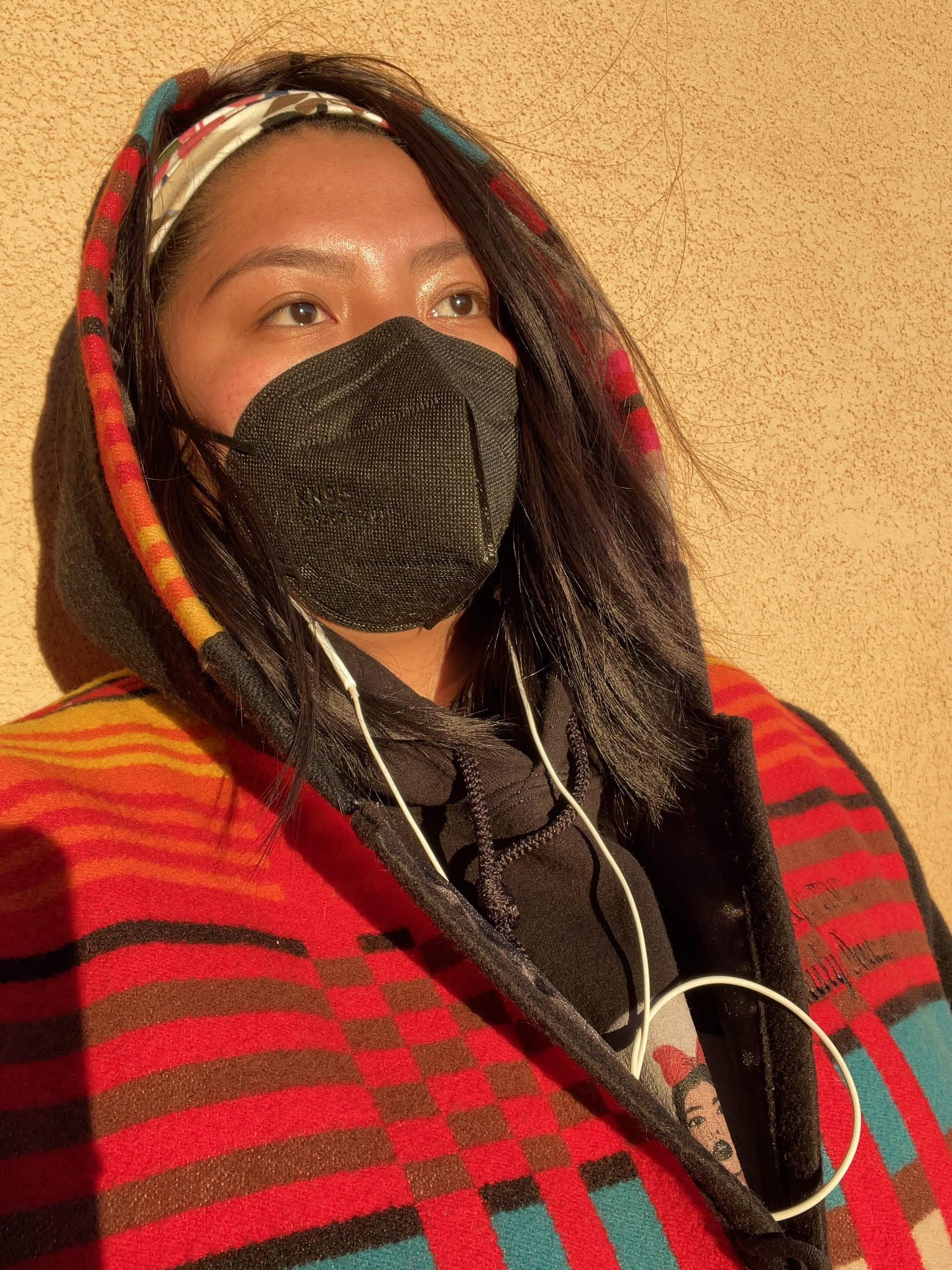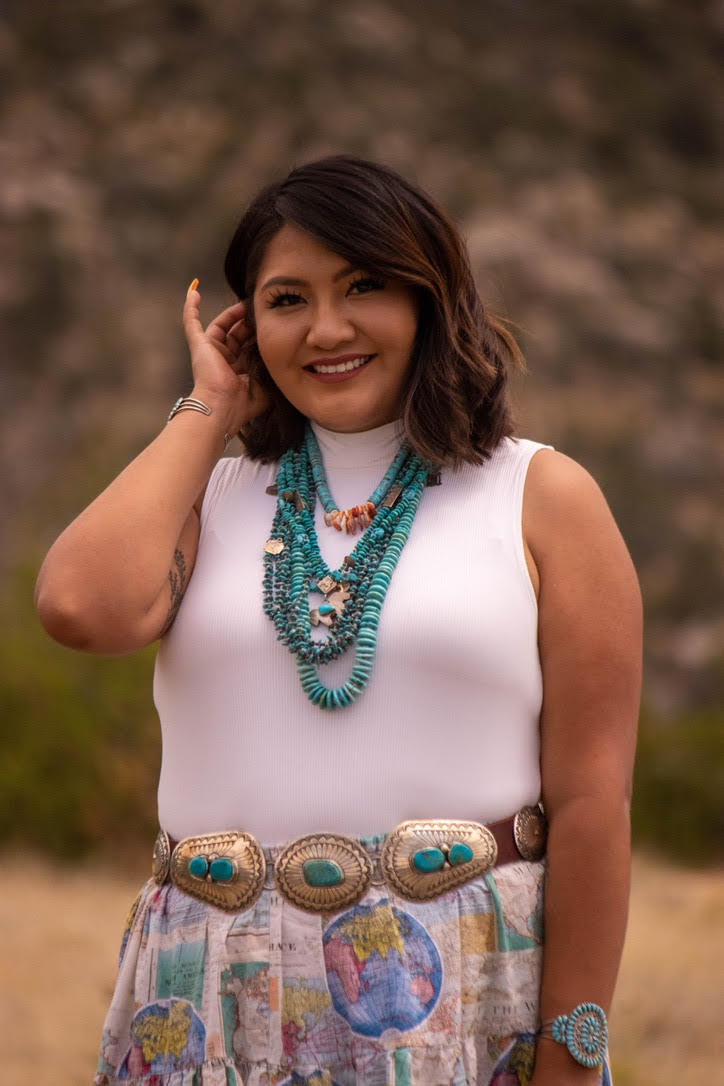
- Details
- By Pauly Denetclaw
A Snapchat memory popped up on the open app. It was me wearing a Sáanii Up t-shirt, tortoise shell glasses, and my hair in a messy bun. A caption over my face reads, “Hoping I don’t have Covid.” It was a grim reminder that one year ago exactly my family and I caught Covid-19. I’ve never written about it before because I guess it was too hard and too traumatic.
It started as a sore throat on Friday, December 18, 2020. I thought it was just irritation from some unexplained source because I get sore throats frequently due to dust and allergies. One day later, my sister’s partner, who is a paramedic, felt ill and went to get tested for Covid-19. I was in the car with my friends when I got a text message from my sister. I told them I needed to go home and cried because I was afraid I had exposed them to Covid-19. I apologized profusely. (Thankfully, they never tested positive.)
Our household was quarantined starting on Saturday, December 19, as a precaution and we hoped that it was just a common cold. We thought it was just a common cold. One day later, on December 20, I was sitting down to dinner with my family. I felt malaise and my knees were aching. I checked my temperature with a thermonator I bought after getting the flu for the first time before the pandemic hit in early 2020. It was 101.4. I remember telling my sister and in disbelief she said, “Check it again.” The same number came up. This is when reality set in. My sister told everyone to put their masks on, started disinfecting and handed me a 24 pack of bottled water. I was quarantined in my room.
My older sister, who is a flight nurse, had overcome Covid-19 months before in May 2020. Besides her, no one else in my household had tested positive. We followed guidelines, quarantined, wore masks inside and, while my sister was sleeping, I went around and disinfected the common areas multiple times a day.
This time was different. I was the second person in our home to feel sick. The next day, on Monday, my nephew felt a sore throat come on. Everyone in my household is a first responder at the forefront of battling Covid-19 and I was a journalist out covering the pandemic. We were under the mindset of not if but when we would get Covid as it continued to ravage my community. And it had happened. My whole family got Covid at the same time. It swept through our household the same way as others in my community described.
Day 2
On Monday, December 21, my sister took me to get tested. This was the second time I got tested and it was more comfortable than the first. The first time it hurt so bad. I started coughing so hard I almost threw up. There was an ease the second time around. When I got back home my sister made me sage tea, a green immunity boosting smoothie and green chile stew, (If you’re from New Mexico you know why.)
She created a regiment of vitamin C, vitamin D, a regular daily vitamin, two tylenol, a decongestant and a bottle of water every hour. We were also supposed to drink Gatorade and go for a daily walk. There is a Navajo belief that when you’re sick you have to move around. My sister swore these walks helped her and made all the difference.
The first day we were okay. But over the course of the next 11 days that would change.
Day 5
I had been tachycardic for several days. My resting heart rate was over 120 and started to peak at 150. My sister told me to continue drinking lots of water and said if my heart rate didn’t slow I would have to go to the hospital. She was so concerned about my heart rate that she had her partner double check my heart rate manually. He sat there counting the beats of my heart, commenting it was fast but not that fast. The lowest my oxygen level got was in the low 90s.
This was the most sick I have ever felt. I could barely walk around without getting out of breath, every joint in my body ached so bad that any pressure felt painful, I was so cold that I was constantly getting the chills, I couldn’t sleep because coughing fits would wake me up, my chest hurt, my head hurt and it wouldn’t stop. I prayed several times a day to the Holy People for me, my nephew and my sister’s partner. I prayed until I cried. I drank sage tea, offered corn pollen, burned sage and cedar. I was scared I was going to die…
My mom was bringing us food twice a day and leaving it on the porch. She was bringing us Navajo remedies, checking up on us often and praying as hard as she could. Every morning she would ask if the fever broke. Every morning I had to tell her no. Every day she’d respond, tomorrow is going to be the day. Her undeniable optimism kept me going even though I felt like every day I broke her heart by saying today wasn’t the day.
There was no Christmas miracle on the horizon. And December 24th wasn’t the day and I was worse than ever. Over an egg sandwich on Texas toast that I couldn’t taste and felt too sick to eat I cried. I broke down and told my nephew, who is just three years younger than me, that I didn’t want to go to the hospital, that I was scared, that I thought the hospital would kill me and I wished my heart rate would just go down. He hugged me and told me everything would be okay, that I would be okay.
It was Christmas Eve and Dr. Susan Moore was all over the news. She was a Black doctor who died of complications from Covid-19 after receiving inadequate care. The white doctor didn’t take her symptoms seriously, even doing a scan of her lungs because he didn’t believe Moore had shortness of breath despite her advocating that she did. Moore was in severe pain, had shortness of breath, fluid in her lungs, swollen lymph nodes, temperature of 103, low blood pressure and a heart rate of 132. In the video she posted to Facebook, Moore was clearly in need of medical attention but the hospital was trying to discharge her home.
I was afraid of medical bias and I knew that all the hospitals in my area were full, that people were being transported as far as Salt Lake City for care. I didn’t want to be away from my homelands, family and in a place I was scared the medical staff wouldn’t listen to me because I’m a woman and Native American. I was also worried about how I would get home. Who would come get me? I didn’t want anyone outside of my household to be exposed to me.
Day… Well I can’t remember.
In another life, I was a vlogger. So, it's habit that I take videos about things I’m experiencing. I have one video that still brings tears to my eyes. It’s me trying to describe my symptoms before breaking down into tears, sobbing and saying, “I am in so much pain.” The video is turned up toward the ceiling, all you hear is me crying and the phone is shaking.
My fever didn’t break for 9 or 10 days, I can’t remember the exact number and I stopped documenting at that point because after day 5 I was over it. I just wanted it to be over but every morning I woke up with a fever. Finally, I was in the clear but it didn’t stop for my family. My nephew’s temperature wouldn’t go down, he was feeling really sick, didn’t want to go on our required daily walks and had low oxygen levels.
He came outside one morning and I knew that this was his last day to feel better before my sister was going to make the call to take him to the hospital. I told her jokingly that I would barricade the door before I let him go because I was scared for him to go to the hospital. Again because of medical bias.
But my momma had one last Navajo remedy up her sleeve. She dropped it off at the door, told me the instructions and I woke my nephew up. I brought him to the medicine and that night everything turned around for him.
By New Year's Eve, none of us had a fever anymore. We had made it through. My sister took us to get retested and we sat in the backseat of her truck, wearing our masks and listening to country music.
I only have one reflection from after my experience. A poem I wrote after I got better:
sickness showed me
life one day at a time
where the future had no room to exist
because every breath was a struggle
to pull oxygen from sky
into my chest that was at war
the sun came & went
but the sickness remained
for days & days
until I swore it wasn’t gunna leave
that’s when it became the most frightening
so I called on my ancestors,
& Diyin Diné’e to keep me strong
& they came, nestled in my spirit
until I was well enough
to carry resiliency on my own
now, I still feel their love
engulfed in their light & their healing
& I will carry that into the next new year
in light & gratitude
Please wear your mask, get vaccinated and get boosted.
More information: https://www.cdc.gov/coronavirus/2019-ncov/vaccines/booster-shot.html
More Stories Like This
Tribes Do Not Need a Greenlight to Build Renewable EnergyLaw Should Not Get in the Way When "Manifest-ing Destiny"
Celebrating 35 Years of Gaming Success
My Tribe’s ICE Contract Betrayed Our Values
Extending the Affordable Care Act Is a Moral Imperative for Indian Country
Help us defend tribal sovereignty.
At Native News Online, our mission is rooted in telling the stories that strengthen sovereignty and uplift Indigenous voices — not just at year’s end, but every single day.
Because of your generosity last year, we were able to keep our reporters on the ground in tribal communities, at national gatherings and in the halls of Congress — covering the issues that matter most to Indian Country: sovereignty, culture, education, health and economic opportunity.
That support sustained us through a tough year in 2025. Now, as we look to the year ahead, we need your help right now to ensure warrior journalism remains strong — reporting that defends tribal sovereignty, amplifies Native truth, and holds power accountable.
 The stakes couldn't be higher. Your support keeps Native voices heard, Native stories told and Native sovereignty defended.
The stakes couldn't be higher. Your support keeps Native voices heard, Native stories told and Native sovereignty defended.
Stand with Warrior Journalism today.
Levi Rickert (Potawatomi), Editor & Publisher

